FROM SHoGUN TO GODZILLA
A GRAPHIC GAMEBOARD HISTORY
OF MODERN JAPAN
Watch the Sugoroku Video:
For centuries, sugoroku, paper gameboards, have been created about every aspect of Japanese history and culture. Themes included war, women’s and girls’ interests like fashion and flower arranging, sports, education, public health, adventure and exploration, nursery and folk tales, humor, moral lessons, advertising, and politics. Journalism of current events and almost every significant incident and social movement from mid-19th to mid-20th century Japan appeared on sugoroku, many of which were published and disseminated as inclusions in mainstream sources of print news - newspapers, magazines and publications for children. Except for a few intermittent gaps, it is possible to tell the story of Japan from its opening to the West until post WWII, by studying the content of picture sugoroku, a largely unexplored, but deep and fertile repository of history.
While traditional ukiyo-e wood-block prints are justifiably revered world-wide for their sophistication and beauty, sugoroku from Meiji (1868) and later, some wood-block but mostly lithographic, are barely mentioned in Western literature. Important ukiyo-e artists produced sugoroku but the serial nature of the games and contemporary themes they portrayed isolate them as a stand-alone art-form, related, but separate from traditional ukiyo-e. While culturally diverse story-telling traditions in art existed before the advent of comics and manga, sugoroku, which pre-date both, were also stories - pictorially sequential information. Like the flip-books and optical toys that pre-dated cinema, sugoroku are abstractions of events unfolding in time.

19.5 x 30”
Ukiyo-e by Utagawa Yoshitora (1836 – 1880). The beginning of the modernization of Japan with Commodore Mathew Perry’s “Black Ship”, (with incorrect American flags), a passenger balloon, and a steam-powered fire engine.

28 x 28”
Ukiyo-e by Tsukioka Yoshitoshi (1839 – 1892). Depicting the “Satsuma Rebellion.” The Tom Cruise movie, The Last Samurai, is based on this uprising and the last gasp of samurai culture as Japan westernized with weapons and education imported from, particularly, the U.S. and Germany.
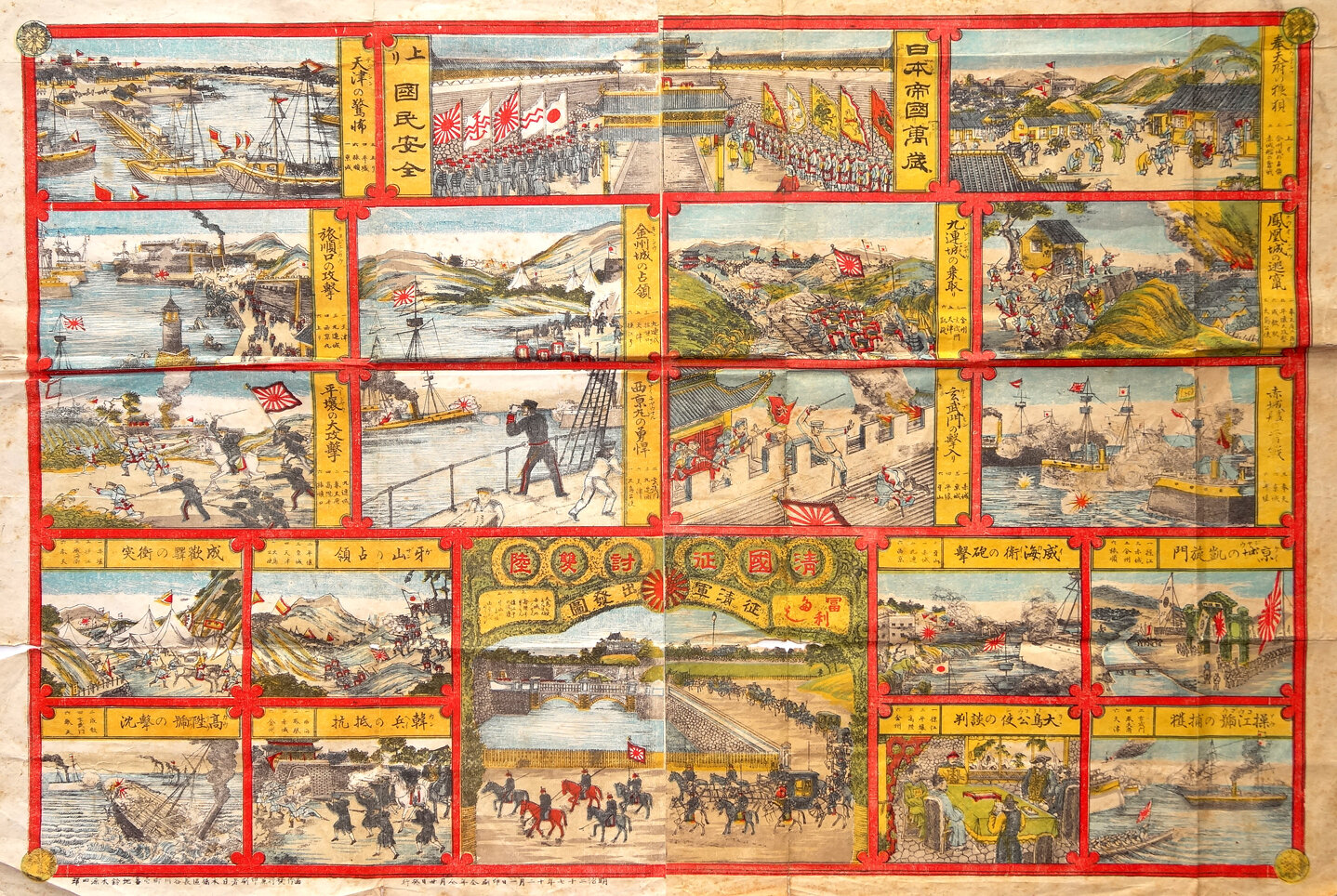
24.5 x 35”
Ukiyo-e. The last panel, lower center, shows the Meiji Emperor’s retinue leaving the Imperial palace in Tokyo.

29 x 19.25
Ukiyo-e. The large panel lower right depicts a Japanese General in Western uniform accepting the surrender of the traditionally attired Chinese, a not so subtle expression of Japan’s superior modernity.

31 x 19.25”
After its opening to the West, Japan eagerly embraced modern technology, particularly railroads and weaponry.

15.25 x 21.5”
Detailed Map with Russian Troops, Quick Reference of Uniforms and Deployment of Soldiers. Figures throughout represent the accurate array of the forces of Japan, Korea, China, and Russia.

14 x 19”
This beautiful portrayal of the battles of the Russia war at right are paired with advertising at left. Other example of this were likely to have been printed with different advertisers and distributed as hand-outs.

15.25 x 21.25”
The names of dozens of actual ships are noted included the Mikasa, number 50, the flagship of the War’s hero, Vice Admiral Tōgō Heihachirō (1848 – 1934). The Mikasa, built 1899, is the last remaining battleship of her era in existence. It is a museum now.

15.5 x 21.5”
Hints of Art-Nouveau, at its height in Europe the year this was printed, are discernable in the background of cherry blossoms and chrysanthemums.

21 x 30.5”
This advertising game shows businesses that likely paid to be featured. Included are a kimono shop, restaurant, rikisha (rickshaw) dealer, beer company, watch shop, art shop, photo studio, drug company, seaweed shop, wine merchant, hotel, pawn shop, flag shop, safe dealer, jeweler, grocery, and cinema, with the Mitsukoshi Department store, founded in 1673 and still thriving in the Tokyo Ginza neighborhood, as the final goal.

21.5 x 15.5”
Each person shown is a legendary shogun, emperor, prince, monk, etc. who is paired with a short poem on a second sheet of identical size. The man being shot (bottom row, third from left) is politician Ito Hirobumi, who was assassinated by Korean activist An Jung-guen in 1909.

21.5 x 31.25”
The graphics on this are among the most sophisticated in the collection. The artist must have been aware of European modernist poster and graphic design.

25 x 37”
Up to date military hardware is shown here with horses and a pigeon outfitted with a camera (box 15). The Japanese celebrated the animals they utilized in battle, even awarding medals to some.

21.5 x 31”
Pilots are put through harsh training in this bizarre game - forced to listen to nearby cannon blasts, dropped from a balloon to netting far below, sitting on ice, and spun on centrifugal contraptions.

21.25 x 29.5”
Drawn by Eiji Ikeda (1889-1950), a famed Manga artist in the early 20th century. The airplane play pieces are printed at left for scissoring.
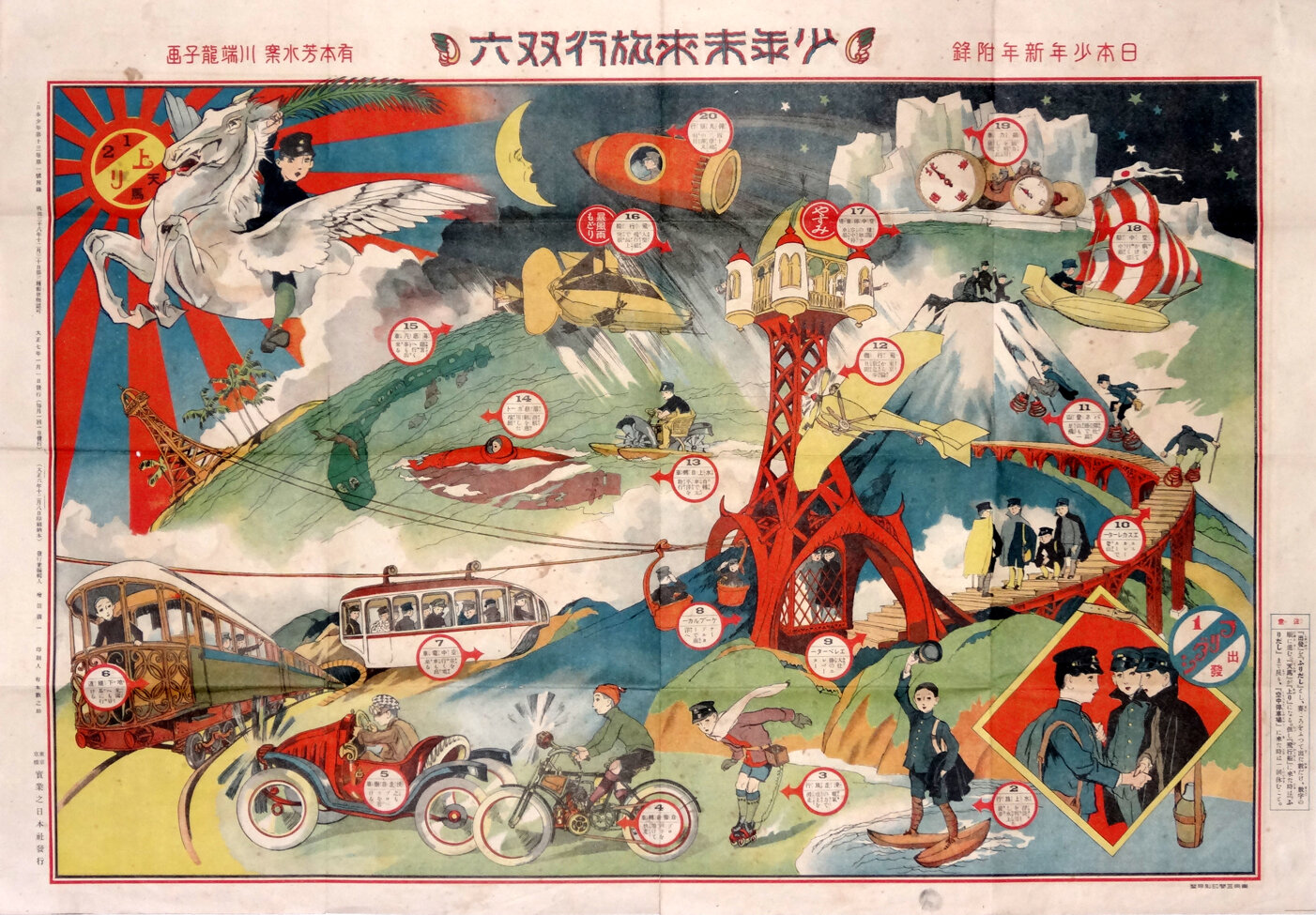
21.25 x 32”
Many futuristic concepts are illustrated here including a magnetic car, air train, seabed locomotive, bicycle on water, air ship, spring-shoe mountain climbing, electric skates, space flight to the moon, and more. The artist, Kawabata Ryūshi (1885 –1966), traveled to the U.S. in 1913 to study western-style painting. American humor illustration in magazines like Puck and Life and Winsor McCay’s great comic strip, Little Nemo in Slumberland, all of which were widely disseminated in 1913 when the artist was living in the U.S., are likely influences on this piece.

15 x 21.25”
Showing the reverse of normal. So the little girl is being given toy artillery while a boy gets a doll, a horse is pulling a car, mice have a cat in a cage, etc. Gorgeous graphics.

21.25 x 31”
The Olympics were held in Antwerp, Belgium in 1920, Paris in 1924.

31.5 x 21.5”
Fantastic graphics. All the girls are in Western clothes except for two in kimonos on the ground. The 1920’s was a decade of great modernization in fashion and art in Japan.

21 x 31.25”
The devastation left by the 1923 Kanto Earthquake inspired artistic speculation for rebuilding. Shown here are a 1) Subway System 2) Elevated Train (Monorail) 3) Irrigating airplane (crop-duster, but with water) 4) Grand Boulevard 5) Rooftop Pool 6) Water Park 7) Drawbridge 8) Listening to Music on the Radio 9) Travelling to the Moon 10) Sports Stadium 11) Black & White Moving Pictures (Movies) 12) Rooftop Runway 13) Portable Radio For Communication (Mobile Phone) 14) Large-Scale Market For Items Ranging From Trains To Houses.
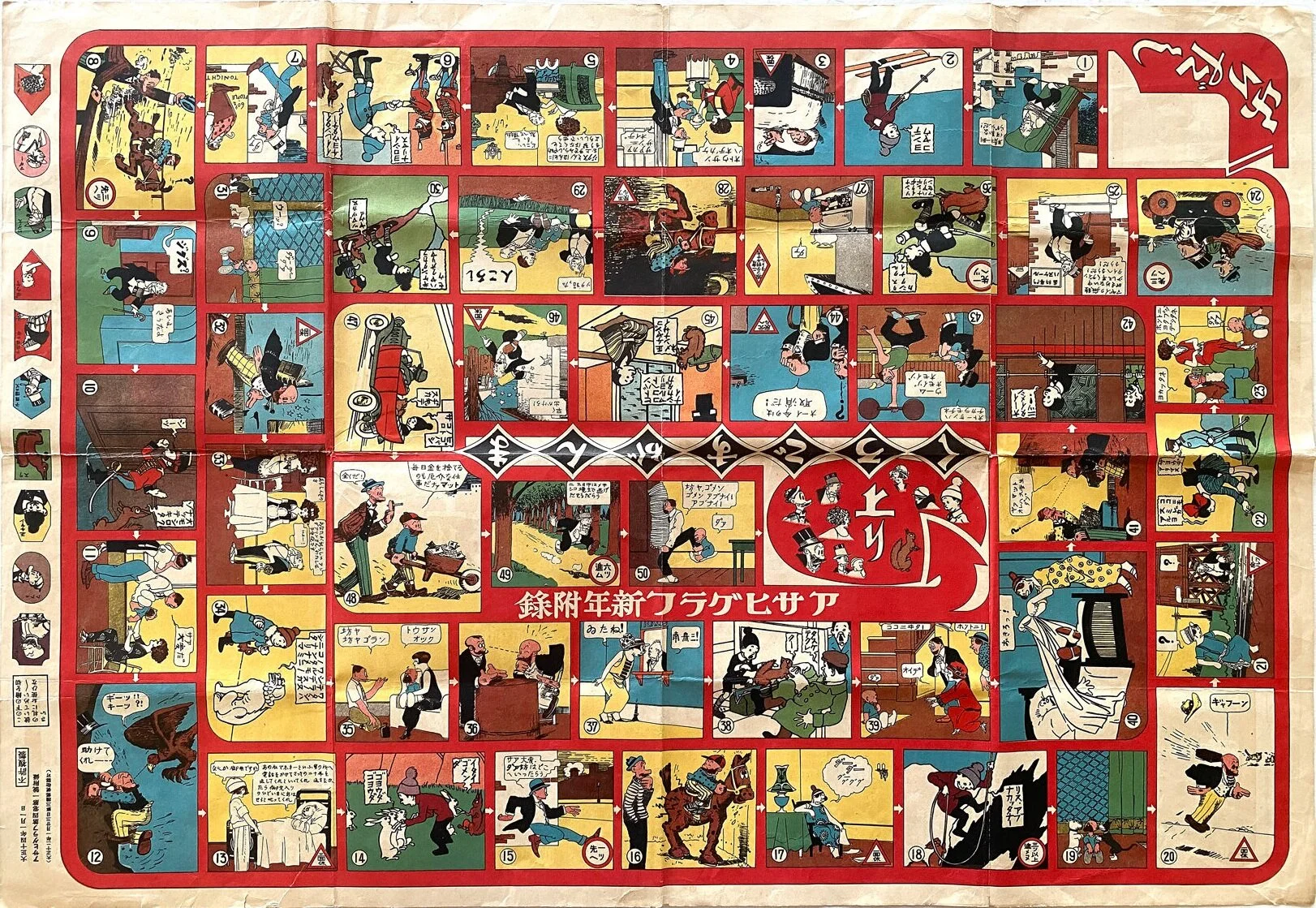
21.25 x 30.75”
A remarkable compendium of popular American comic strip characters from the mid-1920’s, all with Japanese text balloons. Including Mutt & Jeff, Barney Google and his horse, Sparkplug, Jiggs and Maggie from Bringing Up Father, and, although he is not shown, the brick (and other flying objects) from Krazy Kat.
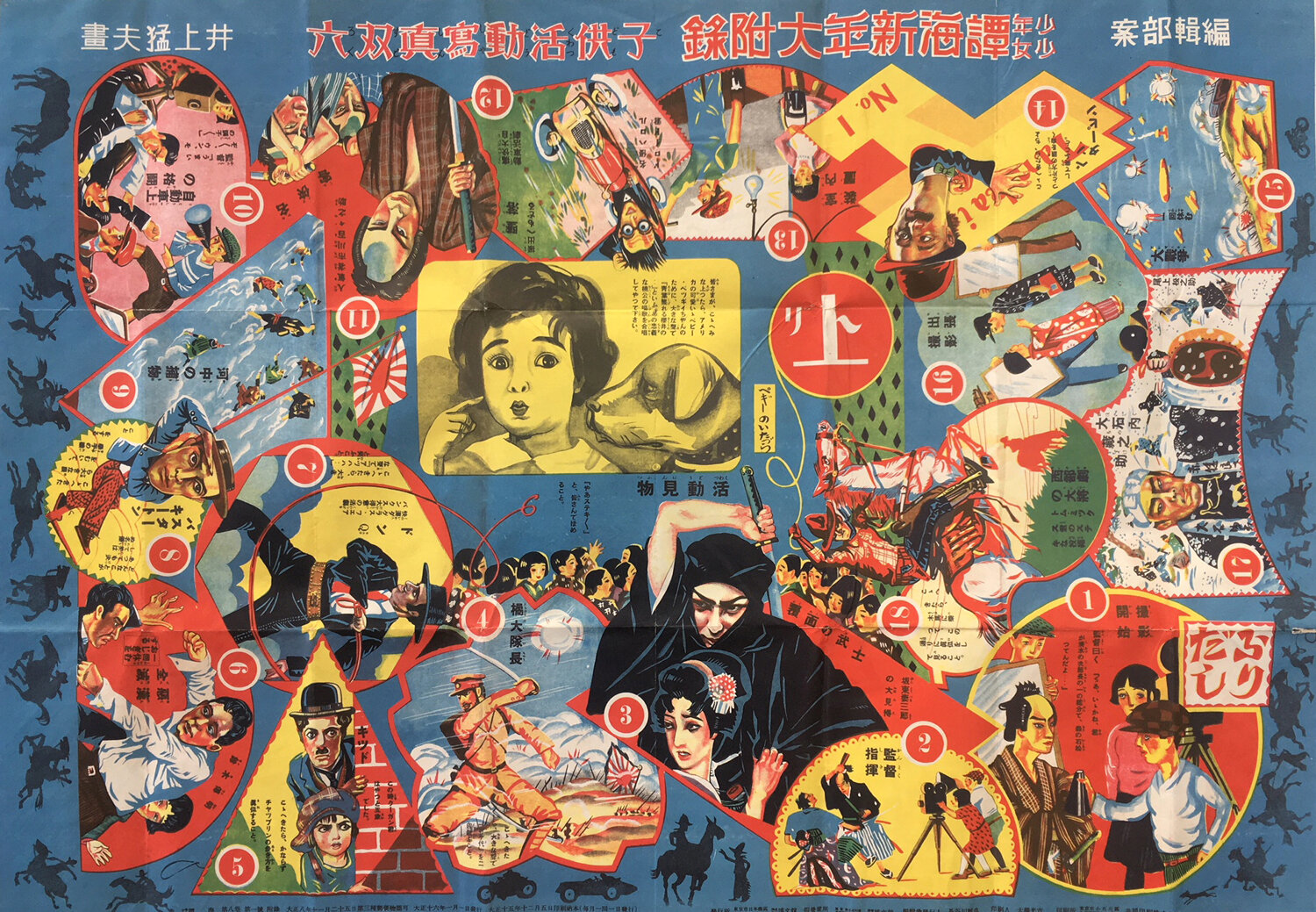
21.75 x 30.5”
An overview of the silent films of the era including Japanese and Western movies with Shirley Temple, Harold Lloyd, Buster Keaton, Tom Mix and more. Includes an image of a famous scene from “The Kid” with Charlie Chaplin and Jackie Coogan.

15.75 x 21.65”
Along with the flags of the U.S., UK, and France, in the center star, is the five-bar flag of the Chinese Republic that was in use from 1912 – 1929. The five colors represented the five major ethnic groups of China - the Han (red); the Manchus (yellow); the Mongols (blue); the "Hui" (white); and the Tibetans (black).

30.75 x 43.25”
Advertising, beginning with the Morinaga Snack Company lower right corner and ending with the Yokohama Koshin Bank in the center. Along the way you pass, among many others, a butcher, kimono shop, seaweed store, and wine shop.

31.25 x 21.25”
A fantasy Japanese flight based on an actual circumnavigation by two French pilots in 1927, 1928.
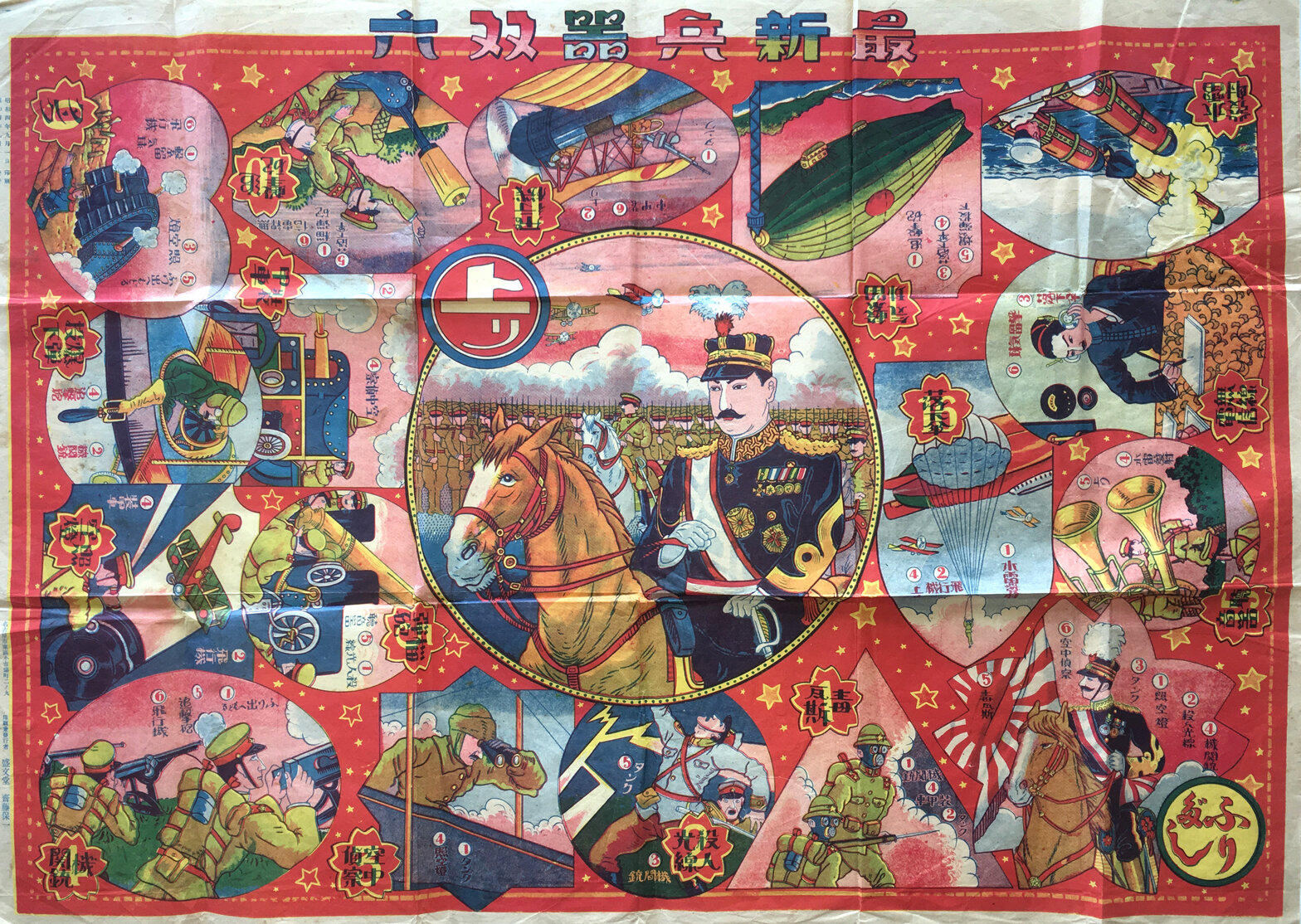
23 x 32.7”
Included on the right side of this zesty celebration of modern warfare are the acoustic locators, like huge Victorian ear trumpets, that were first used to pinpoint ships in fog and later incoming aircraft. They often appear in propaganda of this period as proof of Japan’s modernity.

21.5 x 28.5”
Published to commemorate the visit to Tokyo in 1929 of the LZ 1127 Graf Zeppelin while on its famous round the world trip known as Weltrundfahrt 1929, or Graf’s “Round the World” flight in August 1929, which officially began and ended at Lakehurst Naval Air Station in New Jersey.

21 x 31”
A remarkable piece of science fiction art including a classic future city based on 1920’s images in American pulp sci fi magazines like Amazing Stories by artists like Frank R. Paul. The vignette of a robot lecturing to crowds of robots while another gives a fascist salute is unknown in any science fiction I’ve seen.

18.5 x 24”
As shown in the circle lower right, Japanese troops dynamited their own railroad in Manchuria, blaming it on local rebels, as an excuse to invade China. Thus starting the Asia War that only ended in 1945 at Hiroshima and Nagasaki.

21.5 x 31”
Norakuro the army dog, a comic strip that began running in 1931, was the first Manga. His black and white look was lifted from Felix the Cat.

25.25 x 36”
Published by the patriotic women’s association offering inspiration and lessons to the women of Japan as the increasingly military-driven country dreamed of an expanding empire. From education to air defense.

25 x 37”
Japanese swimmer, Hideko Maehata, (bowing center) won the gold medal in the breast-stroke in the 1936 Nazi Olympics. A German swimmer, behind her with raised arm, got the silver. This Olympics is well-known in the US for the four gold medals won by runner, Jesse Owens, he appears in circle number eleven.

21.25 x 31”
Sugoroku with war themes were published in magazines for the very young.

21 x 30.25”
Remarkable modernist graphics similar to German and Russian Constructivist poster art.

21.4 x 30.9”
The planes shown are all actual aircraft used during the 1937 war with China, transitioning from bi-planes to single-wing.

21 x 31”
A New Year treat from the magazine Seugaku Sophomore (for the second year of primary school). When 'Shining Japan' - Kagayaku Nihon, became a motto for war in Asia is unclear. The 1936 Shining Japan Exposition was essentially a military display although Japan had long crusaded and fought for Pan-Asian peace, liberated from colonialism. The name surfaces still, used by ultra-nationalists in Japan.

18.25 x 24.5”
Published shortly after the start of the campaigns in China that lasted until 1945. The medals at left are the play pieces for scissoring.

21.25 x 30.75”
One of the worst years of the Second Sino-Japanese War when Chiang Kai-shek’s Nationalist army and Mao’s Communists took a break from fighting each other to concentrate their efforts against the Japanese.

18.5 x 24.5”
A war game for the pre-school set with tanks and fighter planes. The Japanese indoctrination of boys to militarism started when they were 30 days old at their, Shinto miyamairi naming ceremonies.
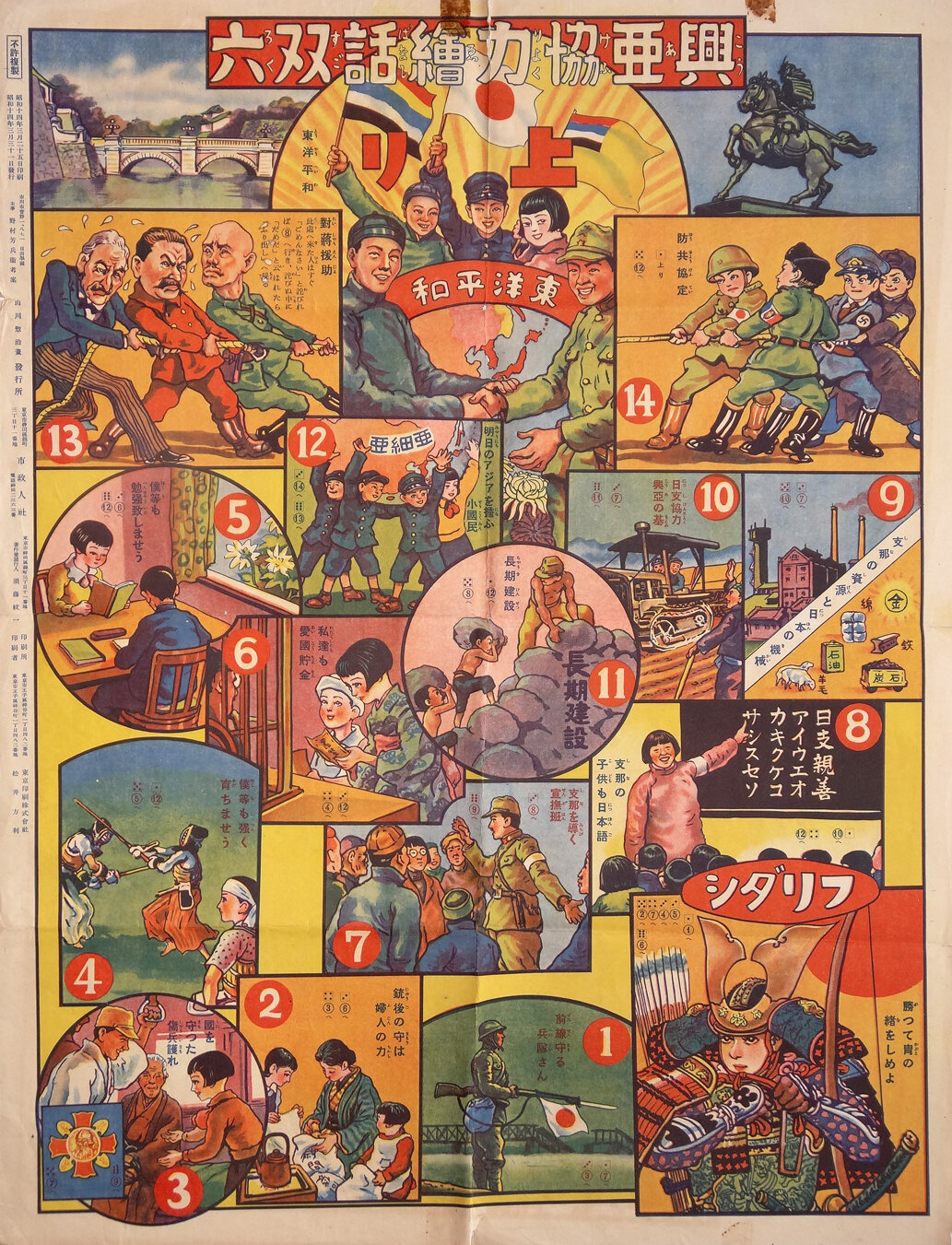
20.75 x 16”
Uncle Sam, Stalin, and Chiang Kai-shek in a tug of war across Asia with boys in the military uniforms of Japan, Italy, Germany, and Manchuria.
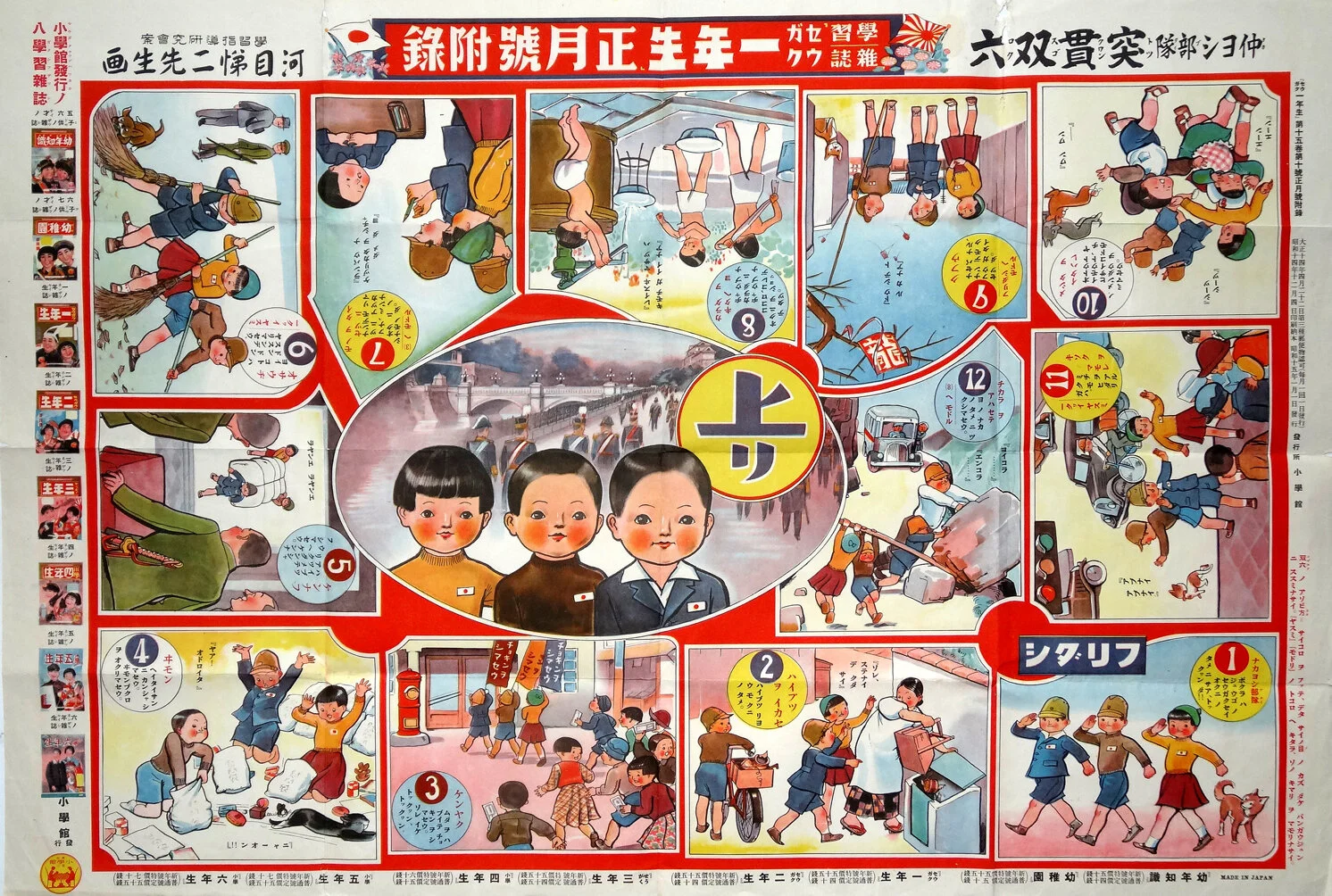
21.25 x 31.25”
Children pitching in for the war effort well before Pearl Harbor. During WWII, children worked in factories in Japan. Many starved. The center panel shows three bright-eyed kids in front of the emperor’s palace in Tokyo, each wearing a rising sun pin.

20.5 x 29”
Actual battles are portrayed in this graphically rich game. The troops at top center are standing on the Great Wall of China yelling banzai, literally “Ten Thousand Years!”

21.5 x 30”
The Germans occupied Paris on June 14, 1940. Hitler, Stalin, and Mussolini, appear here along with the bombing of London. The "Axis powers" formally took that name after the Tripartite Pact was signed in Berlin by Germany, Italy, and Japan on 27 September 1940.

21 x 30.5”
Activities on the home front to aid in the war effort.

15 x 21”
With photos of Subhas Chandra Bose (India), Ba Maw (Burma), Wang Jingwei (China), and Jose P. Laurel (the Philippines), who were the presidents and political leaders of Imperial Japan’s puppet states in East Asia during the Pacific war.

15 x 21.4”
All manner of motorized vehicles from the 1950’s appear here with futuristic transportation in the center panel based on actual American streamline locomotives of the 1930’s, Norman Bel Geddes’ streamline ocean liner design, and a single finned car very much like a Tatra. Japanese technological futurity is a leitmotif in most of the earlier militaristic sugoroku. The impulse was transformed after the War into futuristic concepts and wacky science fiction.

21 x 29.25”
Fantastic futuristic architecture and transportation with antecedents in American streamlining of the 1930’s.

20.25 x 28.5”
The space exploration imagery here was copied verbatim from the 1949 book, Conquest of Space, by Willy Ley with art by Chesley Bonestell, as well as the illustrations by Fred Freeman for Colliers magazine published in 1953.

